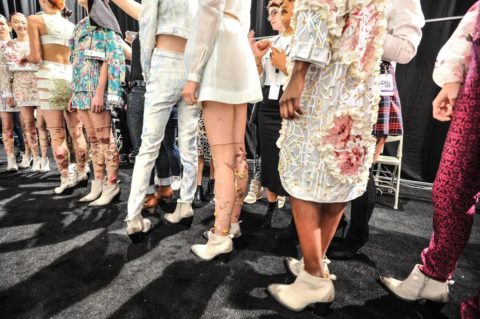The see-now-buy-now model could ruin indie designers

Last week Tom Ford and Burberry made huge announcements that might change the fashion industry forever. If that sounds dramatic, it’s because it is. These mega-brands are rejecting the traditional show system in favour of a see-now-buy-now model. Beginning in Fall 2016, customers will be able to shop Burberry and Tom Ford collections immediately following their runway shows rather than waiting up to six months for clothes to hit stores.
“In a world that has become increasingly immediate, the current way of showing a collection four months before it is available to customers is an antiquated idea and one that no longer makes sense,” Ford said in a release.
Many shoppers and industry insiders responded to this news with a collective “finally!” In the age of blogs and social media, consumers see collections immediately and want them immediately. If large brands don’t deliver, people simply go to a fast fashion retailer and buy a copy that is available.
Caroline Rush, chief executive of the British Fashion Council, told the New York Times that “this strategic move shows brilliant leadership from [Burberry] in driving this agenda forward.”
There’s just one problem. If the see-now-buy-now model becomes industry standard, it risks putting many indie designers out of business.
Traditionally, designers make samples, present them to buyers at fashion weeks, take orders, then produce and ship them to stores. This process is why it takes several months for collections to hit sales racks.
Designers rely heavily on advance orders from retailers to align their production costs and decide how many pieces to order. If they have to produce an entire collection to sell right after they show, the process dissolves into guesswork that could leave them high and dry.
“If we were to show in September and make all of our clothes ahead of time to sell the following week, we’d have to forecast what our sales are going to be and make sure we have enough funds to get the production done,” says Toronto-based evening and bridal wear designer Christopher Paunil. “It’s not something someone at my level could keep up with because it involves a lot of costs upfront without any guarantee of sales.”
“It’s extremely difficult to finance,” says David Dixon, who designs his popular eponymous label. “And no one wants leftover inventory. That’s death in the fashion business.”
“If this become the norm, it just wouldn’t work,” agrees Laura Siegel, an eco-conscious Toronto designer who currently only produces clothes once she gets orders in from retailers. “It would be really bad. The margin of error for fashion businesses is very small.”
Even if an indie label figures out how to finance production costs and thinks they can predict what will sell, they still won’t be able to turn around collections nearly as fast as large international brands. Unlike the Burberrys and Tom Fords of the world, small brands don’t own their production facilities and instead have to share factories with other labels—all vying to get their orders done as quickly as possible.
“Your product might not be ready when you want it because factories are also working with other designers,” explains Paunil. “We’re doing a small 50-unit run for one of our stores right now, but we’re not the manufacturer’s top priority because they’re also working with other brands in Toronto that are a bit larger like Wayne Clark, Smythe and Lucian Matis.”
“Manufacturers are concerned with their largest client because that keeps the lights on,” says Mel Ashcroft, co-founder of Toronto-based fashion consulting firm The Collections. “If you’re someone who’s producing small orders, you’re not necessarily the main priority.”
Then there’s eco-minded designers like Siegel, who uses artisans around the world to produce her garments. When your items are being hand-sewn and dyed in rural India, you can’t exactly speed up the process. “Most of our pieces have a four to six month lead time between when we get orders and when we deliver to stores,” says Siegel.
The bottom line? “The see-now-buy-now model could potentially put designers like me out of business,” says Paunil.
But that doesn’t mean indie designers are simply giving up. “It’s like Uber and taxis. You can’t stop Uber; everybody loves it. I’m not at the capacity of Burberry. I’m not at the capacity of Zara to have that insane price point, but what am I going to do with what I have instead of whining about it?” asks Felicia Burke, the designer behind made-in-Canada label Bazzul.
The answer, for many, lies in e-commerce and focusing on tried and tested staples rather than reinventing the wheel each season. “It’ll be a different mindset in terms of how we design clothes,” says Dixon.
Last year Dixon experimented with a limited buy-now-wear-now model that allowed customers to order certain dresses and have them completed in three to four weeks. It was successful, but Dixon says those aren’t necessarily the dresses he shows on the runway: “They’re dresses that are the bread-and-butter kind of thing.”
“I don’t have 40-piece collection, you have to edit and focus on a few pieces,” says Burke. “You can predict the sales with products that have gone through a few life cycles. Then you make them in new colourways and sell them online so that you get full profit rather than going through a retailer.”
“The see-now-buy-now trend can benefit emerging designers if they can find ways to have closer relationships with consumers and find out what they want,” says Ashcroft. “So for example, having a Shopify site where they can market their collections and immediately have the pieces online.”
“Of course the change is scary,” says Burke. “But it’s about choosing to find the light at the end of the tunnel when things like this happen.”







